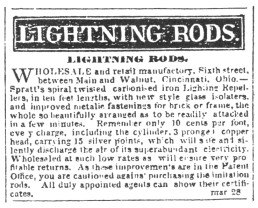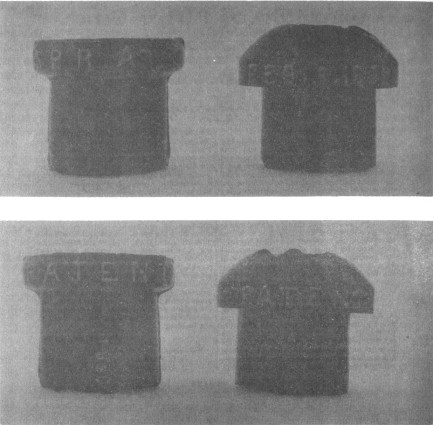James Spratt Insulators
Reprinted from "INSULATORS - Crown Jewels of the Wire", August 1975, page 6
Dear Mrs. Harned:
This letter has two objectives. First, with the assistance of wife Sandra, I
have a fairly extensive specialty collection of PATENT DEC 19, 1871 insulators.
Over the past three to four years I have spent a lot of time researching and
cataloging the various features of these insulators. One item continues to haunt
me, however. That is the alleged CD 106, page 57, line 32, Milholland's 3rd
Revision, "Most About Glass Insulators"; also line 250, 1975 price
guide. I would appreciate very much hearing from anyone who has one of these in
his collection. I would like to know dimensions, embossing, and color -- a
photograph would be terrific. My objective is to put together as complete a
listing of confirmed styles and variations as possible.
The second purpose is to respond to Howard Knight's letter in the June issue.
I spent many hours in the Cincinnati library during the winter researching
this and that, but especially James Spratt and his inventions. Mr. Knight's
insulator is one of the Spratt insulators, Circa 1850-1858, and is identified
as such from its unique shape and the 5 February 1850 patent date. There are a
lot of loose ends pertaining to Spratt's life that I haven't tied down yet, but
the following is a brief summary of his activity in the lightning rod business.
Sincerely,
Glenn and Sandra Drummond
JAMES SPRATT INSULATORS
James Spratt opened the Electric Lightning Rod office on 5th Street,
Cincinnati in July 1848. His first contribution to the trade was screw couplings
between lengths of rod. I have been unable to determine if that was original
with him; nevertheless, he did not patent the concept. His next idea pertained
to the alloy used to make the points. This resulted in his first patent (No.
7,008, 8 January 1850) which reads like a real witches' brew.
The first
reference to insulators appears in his advertisement in "Cist's Weekly
Advertiser" beginning on 28 March 1848 (copy enclosed).

I have been
unable to determine when he submitted the application for the insulator
patent, but the advertisement date suggests late 1847 or very early 1848. He
was eventually granted patent No. 7,076 on 5 February 1850 for "Improvement
in Attachments for Lightning-Conductors." This is, to the best of my
knowledge, the first insulator patent. Perhaps it was a colloquialism, but I
find his use of the word "isolater" in the advertisement and the
patent specifications to be odd. (Not being a native Cincinnatian, I find that
there's still a lot of odd word usage here.) He continued his interest in alloys
and obtained a second patent for points (No. 8,930, 4 May 1852).
Note that Mr. Knight's insulator is different from the one shown in the
patent drawing. We have three different styles of Spratt insulators. One is
identical to the patent drawing and is embossed SPRATT//PATENT. It is a light
flint glass aqua. We acquired it after the enclosed picture was made. Another is
like Mr. Knight's (also plate 80, No. 11; "The Glass Insulator, A
Comprehensive Reference"; p 131), but it is a very deep green. The third is
very similar to some J. H. Westons in our collection and is also a very deep
green. It is embossed SPRATT//PATENT on the collar and 1850 on the face of the
lug. The first style seems to be the most unusual.

James Spratt owned and operated the works until 1852, having moved to 31 6th
Street in 1848. He sold the shop to Phillips and Porter in 1852 and turned his
interest to fruit cans and jars. Phillips apparently provided the financial
backing, for Porter and Porter acquired complete control of the shop in 1852,
with Phillips becoming head of a local iron works. W. W. Waddell became owner in
1854, although Porter continued to run the shop. J. H. Weston bought the shop in
1858. Porter and Waddell marketed their lightning rod systems under the Spratt
name. Weston, however, dropped all reference to Spratt and called his shop the
Ohio Lightning Rod Works. We have a copy of a booklet published in 1857 by
Wright, Hunter, & Co. which builds a case for how great the Otis system was
and how terrible and dangerous the Spratt system was. The frontispiece of that
booklet shows a sketch of a Spratt rod with insulator styles 2 and 3. I suspect
that Weston copied his first insulators from the Spratt styles, and maybe
somewhere there is a style 2 embossed J. H. WESTON.
I have been unable to determine where the Spratt insulators were made. The
Cincinnati Flint Glass Works existed between about 1842 and 1850. It was a small
shop, and its products are unknown. The Moscow Glass Works at Moscow, Ohio,
about 25 miles upriver from downtown Cincinnati, was in operation throughout the
era that Spratt insulators were made. The Moscow Works was a large and
productive operation for the time and place, but little information survives to
determine what products were made. The Gray and Hemingray works was started in
early 1848. Their advertisement of 1851 states that they were making lightning
rod insulators; however, it is improbable that they could have been involved
with Spratt in the development of his first "isolaters" prior to 1848.
It is also possible - maybe probable - that the insulators were made in the
Pittsburgh area. Pittsburgh was the leading glass producing town in the
"west" at that time.
I find it difficult to place a value on the Spratt insulators. They are
perhaps the oldest embossed insulators of any type and are certainly not
plentiful. I observe, however, that the "average" insulator collector
does not relate them to telegraph and telephone insulators and, furthermore,
does not appreciate their historical significance. Even stranger, advanced
collectors will pay much more for the relatively more common Otis "wiggle
top". We have been able to obtain the three SPRATTS in our collection for
under $10, although none of the three is in mint condition. We have seen these
insulators sit on the table at shows for $25 to $45 and not sell, while the
"wiggle tops" were being bought at about $75 or more.
We hope this has added a little more to the insulator story. And we would
like to hear from anyone who has a different style or color variation of the
Spratt insulators.
|
